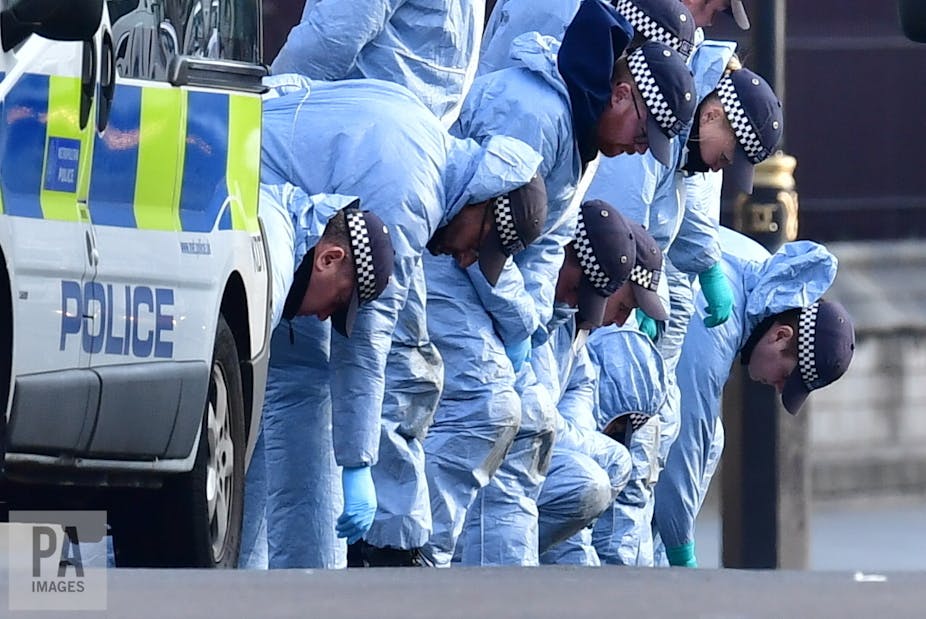Two questions have been particularly prominent in the aftermath of the attack at Westminster. First, why was the attacker – named by police as Khalid Masood – not apprehended beforehand, given that he appears to have been already known to police and intelligence services? Second, what does this attack mean for security in London and elsewhere?
The UK’s counter-terrorism architecture involves a five-tiered warning system organised around five levels of threat: low, moderate, substantial, severe and critical. It is similar, in this sense, to the colour-coded warnings of the US Homeland Security Advisory System – a system which was replaced in 2011 by the National Terrorism Advisory System. The current level remains at severe in the wake of the Westminster attack.
Under the UK’s system, the country can never be entirely free from the threat of terrorism: at best an attack is seen to be unlikely. The simplicity of this system also implies that threats such as terrorism can be accurately, or even objectively, measured – and their increase or decrease calculated and compared.
Questions of probability
Assumptions such as these are misleading, because terrorism threat assessments, like assessment of any type of threat, involve an inescapable element of judgement and interpretation. Prospective dangers have to be translated into calculations of likelihood and potential consequences in order to become threats. Decisions then have to be made about the relative importance of probability and impact in calculating the severity of any such dangers.
In the case of terrorism, we are dealing with the actions of people whose intentions and behaviour may be unpredictable and are almost certainly deliberately concealed. They are also likely to adapt to changes in the environment around them, including the actions of counter-terrorism professionals.
Despite these difficulties, the desire to measure the threat of terrorism is an understandable one. Politicians, police forces, intelligence services and others have a responsibility to maintain national security. They also all play an important symbolic role which involves reassuring the public by being seen to be aware of, and responsive to, current and future dangers.

The problem, in the case of counter-terrorism, is that future events, which cannot be definitively known, get translated into concrete representations of threat based upon the interpretation and judgement of security professionals. In the process, uncertainties become converted into hyper-cautious or even hyperbolic worst-case scenarios in which we are never, entirely, free from the threat of terrorism.
Political reckoning
Part of the reason for this process is political. Those tasked with national security have to make difficult and perhaps even unwanted choices and trade-offs. As Charles Clarke, who was British home secretary at the time of the 7/7 attacks in London in 2005, reflected to me an interview in 2015:
Tony Blair always used to say, quite rightly, that whatever concerns people had about civil liberties … if, at the end of a day, a bomb had gone off and we hadn’t prepared for it, people were killed even in small numbers, but far worse if it was a weapon of mass destruction or something, then people simply would not remotely accept the argument that we were worried about civil liberties. Now, I think that’s true, and I certainly felt in my particular role as home secretary that it was my principal responsibility to do whatever I could to ensure that the people of the country were safe.
The temptation toward creating precautionary threat assessments is also, in part, psychological, and a product of the human tendency to be more fearful of “exotic” or unusual threats such as shark attacks – or terrorism – than their more mundane equivalents which kill far more people around the world.
The problem, however, is that precautionary and hyperbolic approaches to threat measurement probably don’t lead to very effective counter-terrorism policy. As a consequence, policy tends to be rushed, excessive and often ineffective. This, in turn, can have repercussions for public feelings and experiences of security, especially among communities who might feel directly and deliberately targeted or “suspect”.
So, when discussion turns to “what next” in the aftermath of events such as those London has witnessed – the best advice is to proceed with patience and caution: to let the police investigation run its course before jumping to conclusions about actors and intentions. And, in the process to avoid the temptation to see unusual events such as these as anything other than that: unusual.

